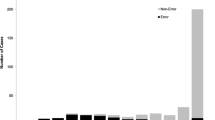Abstract
OBJECTIVE: To determine how accurately preventive care reported in the medical record reflects actual physician practice or competence.
DESIGN: Scoring criteria based on national guidelines were developed for 7 separate items of preventive care. The preventive care provided by randomly selected physicians was measured prospectively for each of the 7 items. Three measurement methods were used for comparison: (1) the abstracted medical record from a standardized patient (SP) visit; (2) explicit reports of physician practice during those visits from the SPs, who were actors trained to present undetected as patients; and (3) physician responses to written case scenarios (vignettes) identical to the SP presentations.
SETTING: The general medicine primary care clinics of two university-affiliated VA medical centers.
PARTICIPANTS: Twenty randomly selected physicians (10 at each site) from among eligible second- and third-year general internal medicine residents and attending physicians.
MEASUREMENTS AND MAIN RESULTS: Physicians saw 160 SPs (8 cases × 20 physicians). We calculated the percentage of visits in which each prevention item was recorded in the chart, determined the marginal percentage improvement of SP checklists and vignettes over chart abstraction alone, and compared the three methods using an analysis-of-variance model. We found that chart abstraction underestimated overall prevention compliance by 16% (P < .01) compared with SP checklists. Chart abstraction scores were lower than SP checklists for all seven items and lower than vignettes for four items. The marginal percentage improvement of SP checklists and vignettes to performance as measured by chart abstraction was significant for all seven prevention items and raised the overall prevention scores from 46% to 72% (P < .0001).
CONCLUSIONS: These data indicate that physicians perform more preventive care than they report in the medical record. Thus, benchmarks of preventive care by individual physicians and institutions that rely solely on the medical record may be misleading, at best.
Similar content being viewed by others
References
US Preventive Services Task Force. Guide to Clinical Preventive Services. 2nd ed. Baltimore: Williams & Wilkins; 1996.
McGinnis JM, Lee PR. Healthy people 2000 at mid decade. JAMA. 1995;273:1123–9.
Benson V, Marano MA. Current estimates from the National Health Interview Survey. Hyattsville, Md: National Center for Health Statistics; 1994. Vital Health Statistics 10 (189).
Audet AM, Scott HD. The uniform clinical data set: an evaluation of the proposed national database for Medicare’s quality review program. Ann Intern Med. 1993;119:1209–13.
Lawthers AG, Palmer RH, Edwards JE, et al. Developing and evaluating performance measures for ambulatory care quality: a preliminary report of the DEMPAQ project. Jt Comm J Qual Improv. 1993;19:552–65.
McGlynn EA. Six challenges in measuring the quality of health care. Health Aff. 1997;16:7–21.
Leshan LA, Fitzsimmons M, Marbella A, Gottlieb M. Increasing clinical prevention efforts in a family practice residency program through CQI methods. Jt Comm Qual Improv. 1997;23:391–400.
Sanazaro PJ, Worth RM. Measuring clinical performance of individual internists in office and hospital practice. Med Care. 1985;23:1097–114.
Dietrich AJ, Goldberg H. Preventive content of adult primary care: do generalists and subspecialists differ? Am J Public Health. 1984;74:223–7.
Carey TS, Levis D, Pickard CG, Bernstein J. Development of a model quality-of-care assessment program for adult preventive care in rural medical practices. QRB Qual Rev Bull. 1991;17:54–9.
Garnick DW, Fowles J, Lawthers AG, et al. Focus on quality: profiling physicians’ practice patterns. J Ambulatory Care Manage. 1994;17:44–75.
Davies AR, Ware JE. Involving consumers in quality of care assessment. Health Aff. 1988;7(1):33–48.
Safran DG, Kosinski M, Tarlov AR, et al. The Primary Care Assessment Survey: tests of data quality and measurement performance. Med Care. 1998;36:728–39.
Woo B, Woo B, Cook EF, Weisberg M, Goldman L. Screening procedures in the asymptomatic adult: comparison of physicians’ recommendations, patients’ desires, published guidelines, and actual practice. JAMA. 1985;254:1480–4.
Romm FJ, Fletcher SW, Hulks BS. The periodic health examination: comparison of recommendations and internists’ performance. South Med J. 1981;74:265–71.
McPhee SJ, Richard RJ, Solkowitz SN. Performance of cancer screening in a university general internal medicine practice: comparison with the 1980 American Cancer Society Guidelines. J Gen Intern Med. 1986;1:275–81.
Hershey CO, Karuza J. Assessment of preventive health care. Design consideration. Prev Med. 1997;26:59–67.
Lawthers AG, Palmer RH, Banks N, Garnick DW, Fowles J, Weiner JP. Designing and using measures of quality based on physician office records. J Ambulatory Care Manage. 1995;18:56–72.
Beullens J, Rethans JJ, Goedhuys J, Buntinx F. The use of standardized patients in research in general practice. Fam Pract. 1997;14:58–62.
Vu NV, Marcy MM, Colliver JA, Verhulst SJ, Travis TA, Barrows HS. Standardized (simulated) patients’ accuracy in recording clinical performance check-list items. Med Educ. 1992;26:99–104.
Schwartz MH, Colliver JA. Using standardized patients for assessing clinical performance: an overview. Mt Sinai J Med. 1996;63:241–9.
Ferrell BG. Clinical performance assessment using standardized patients. A primer. Special series: core concepts in family medicine education. Fam Med. 1995;27:14–9.
Kinnersley P, Pill R. Potential of using simulated patients to study the performance of general practitioners. Br J Gen Pract. 1993;43:297–300.
Peabody JW, Luck J, Glassman P, Dresselhaus TR, Lee M. Comparison of vignettes, standardized patients and chart abstraction: a prospective validation study of three methods for measuring quality. JAMA. 2000;283:1715–22.
Luck J, Peabody JW, Dresselhaus TR, Lee M, Glassman P. How well does chart abstraction measure quality? A prospective comparison of quality between standardized patients and the medical record. Am J Med. 2000;108:642–9.
Gerbert B, Hargreaves WA. Measuring physician behavior. Med Care. 1986;24:838.
Bates DW, Pappius E, Kuperman GJ, et al. Using information systems to measure and improve quality. Int J Med Inf. 1999;53:115–24.
Bates DW, Kuperman G, Teich JM. Computerized physician order entry and quality of care. Quality Manag Health Care. 1994;2:18–27.
Author information
Authors and Affiliations
Corresponding author
Additional information
Dr. Peabody is supported by an Advanced Research Career Development Award for the Health Services Research and Development Service in the Department of Veterans Affairs.
Rights and permissions
About this article
Cite this article
Dresselhaus, T.R., Peabody, J.W., Lee, M. et al. Measuring compliance with preventive care guidelines. J GEN INTERN MED 15, 782–788 (2000). https://doi.org/10.1046/j.1525-1497.2000.91007.x
Issue Date:
DOI: https://doi.org/10.1046/j.1525-1497.2000.91007.x



